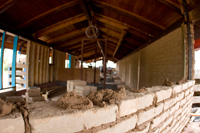By Tishin Donkersley, M.A.
 The rustic gate opens the pathway leading up to the Sandra Day O’Connor House. Up the hill I go until I reach the house that is famous for not only being relocated, but also being the home of the first female Supreme Court Justice of the United States, Sandra Day O’Connor. A gentle reverence comes over me.
The rustic gate opens the pathway leading up to the Sandra Day O’Connor House. Up the hill I go until I reach the house that is famous for not only being relocated, but also being the home of the first female Supreme Court Justice of the United States, Sandra Day O’Connor. A gentle reverence comes over me.
History of movement
The original Sandra Day O’Connor House was designed by architect D.K. Taylor. Taylor reached out to George Ellis, who had previously built adobe houses, to complete the O’Connors’ vision. Within the walls, John and Sandra O’Connor raised three boys and lived in the house until 1981, when they had to move because Sandra was appointed to the Supreme Court. Over the next 20 plus years, the house changed hands. In 2007, the owner decided to demolish the O’Connors’ home. This prompted an intimate group of people to come together and preserve this part of Arizona history. With a cast of Barbara Barrett, Gay Wray, Elva Coor, Viki Budinger, Mike Rooney and Kim Sterling Heflin, they put together a dream team with the help of the City of Tempe, Mayor Hugh Hallman, Rio Salado Foundation and the daughter of George Ellis, Janie Ellis, to preserve the house. Partnering with Sundt Construction, McCulloch Moving, Tim Brown, AIA, Ten Eyck Landscape Architects, Pulte Homes, Jeff Abraham, and Paolo Soleri, the team prevailed in moving the home to its current location in Papago Park, adjacent to the Arizona Historical Museum. The O’Connor House exists to facilitate a space where people and the government can come together and engage in civil discourse.
Today
Rita A. Smith, AIA, board member on the O’Connor House and architect by trade, was my hostess for the day. When asked how she got involved with this entity, she said, “Elva Coor, [chair of the O’Connor House executive committee], was on NPR and I was inspired by this story, and as an architect it took on another interest. I actually called into the show to talk to Elva and see how I could get involved.”
As Rita opened the door, we entered what is considered the kitchen and family room. I looked around at the spacious area, admiring this structure. The historic part of the house consists of the 2,883 adobe bricks, made from the Salt River banks, that make up the walls and fireplace, and the 4,000 square feet of roofline. The foundation, floors and internal steel walls were all new. Interior design includes mid-century modern aesthetic pieces and a desk and two chairs from Justice O’Connor’s collection. From the moment you walk through the door, there is an unwritten message of, “Come in, sit down, let’s chat.”
looked around at the spacious area, admiring this structure. The historic part of the house consists of the 2,883 adobe bricks, made from the Salt River banks, that make up the walls and fireplace, and the 4,000 square feet of roofline. The foundation, floors and internal steel walls were all new. Interior design includes mid-century modern aesthetic pieces and a desk and two chairs from Justice O’Connor’s collection. From the moment you walk through the door, there is an unwritten message of, “Come in, sit down, let’s chat.”
In an article for Arizona Attorney Magazine, Andrea Norman writes, “O’Connor credits her adobe home with providing the setting for compromise and collaboration. Over potluck or specially prepared dinners, Justice O’Connor hosted Democrats and Republicans to reach bipartisan solutions for closely divided issues.”
In the O’Connor House Press Kit, Justice O’Connor stated, “My hope is to re-create a place that will be a center for problem-solving and bringing together groups with divergent views. This House is a great place to do that.”
We ventured outside, and rabbits, lizards and quail scampered away as we walked by. An aloe vera garden was in full bloom and other native plants added to my vision of where the home used to reside. A few steps down, a cement circular seating space with a fire pit in the center is available for congregating.
Back inside, I walked down the hallway to the former bedrooms. The two smaller bedrooms have been transformed into meeting rooms decorated with Arizona memories and pictures of the O’Connor family. Continuing down the hall, I approached the old master bedroom and paused in the doorway. Before me was a rectangular table with 10 chairs, and at the head of the table, placed strategically on the wall, was a stunning picture of Justice O’Connor. To me, the picture set the tone for anyone who entered: Come, sit together, stay civilized and discuss. I was mesmerized by this photograph and stood there for quite some time daydreaming about her efforts to create bipartisanship and the true meaning behind the preservation of this structure. “Spaces can have memory,” my guide Rita said. “The memories of Justice [O’Connor] bring people together [and] resonate within these walls. And that energy can [lead to] civic action.”
Photographer Jon Simpson was a witness to the entire relocation process while creating a short documentary film of the journey. “The experience was analogous to what an adobe house is itself. You have all of these natural materials coming together to provide a loving shelter for the young O’Connor family,” Simpson said. “And in 2007 all of these women came together, and with their love and natural energy they were able to make the dream of relocating and preserving the house a reality.”
 During the transition of the House, I remember the efforts many friends and civic leaders made to make this happen. Unfortunately, my involvement in this project was more from the peripheral. At the time, I didn’t completely understand the true meaning and message behind this home. After experiencing this space with a new set of eyes, I can attest to the need to bring people together, talk and find solutions here at the O’Connor House. With technology at the helm of communication, I still believe there is a value in the face-to-face, and when given the chance to interact, there is more opportunity to understand, clarify and co-create.
During the transition of the House, I remember the efforts many friends and civic leaders made to make this happen. Unfortunately, my involvement in this project was more from the peripheral. At the time, I didn’t completely understand the true meaning and message behind this home. After experiencing this space with a new set of eyes, I can attest to the need to bring people together, talk and find solutions here at the O’Connor House. With technology at the helm of communication, I still believe there is a value in the face-to-face, and when given the chance to interact, there is more opportunity to understand, clarify and co-create.
Current projects of the O’Connor House include public policy, domestic violence, civic education and renewal, Arizona Education Commitment and the public history of Justice Sandra Day O’Connor. The O’Connor House is opening up more opportunities for the community to rent the space for meetings, events and gatherings. I encourage you to learn more about the story behind the movement and consider visiting this amazing piece of Arizona history. Come in, laugh, talk and be – together.
For more information about the O’Connor House and programs, call 480-921-2430 or email oconnorhousevolunteers@gmail.com. To view the Justice Sandra Day O’Connor exhibit visit the Arizona Historical Society in Tempe, call 480-929-0292 or go to www.arizonahistoricalsociety.org.
SOURCES
Jon Simpson
Press Kit provided by O’Connor House
www.supportriosalado.org
Photography by Jon Simpson






